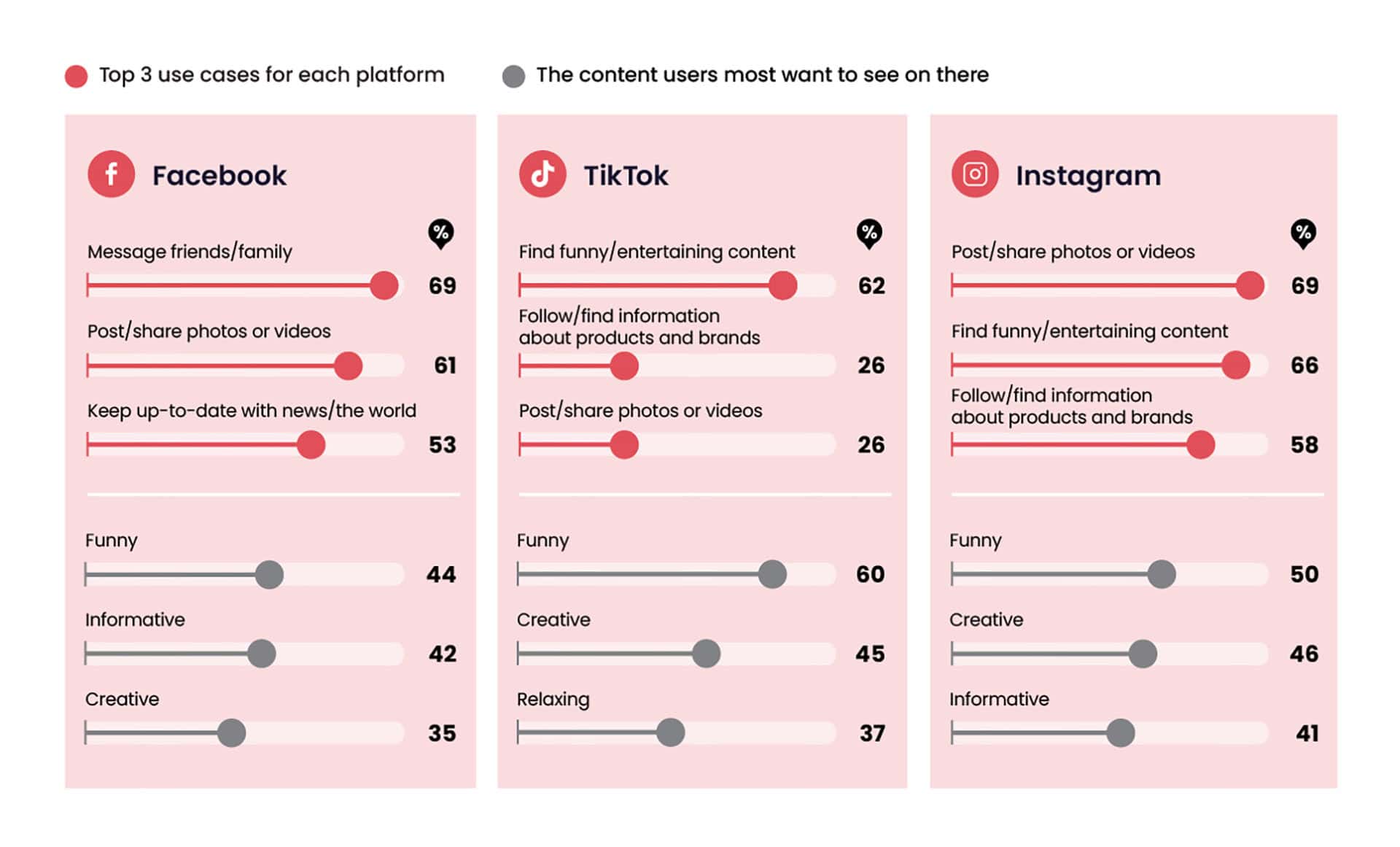Contents
- Introduction
- Set clear, achievable goals
- Research your competitors
- Research your audience
- Choose and understand your platform(s)
- Create a workflow
- Create a schedule
- Keep an eye out for trends
- Leverage social proof
- Repurpose your content
- Analyse, analyse, analyse
- Social media marketing strategy examples
- Need any support?
Are you fed up with posting on social media and getting no followers, likes or comments? It’s more common than you think.
But social media isn’t as simple as just posting content.
Between various platforms, shifting algorithms and evolving audience behaviour, building a working social media strategy requires analysis, research, creativity and plenty of patience.
Most industries are becoming increasingly saturated on social media so, whether you want to increase your follower count to get better reach or receive more likes and comments on your posts having a strategy in place is key.
But how can you cut through the noise?
Whether you’re posting frequently without success or your social media profiles are barren deserts, having a clear strategy in place can bring you increased brand awareness, position you as an authority figure and get you in front of high-quality leads.
Here, we share ten steps to help you build an effective social media marketing strategy in 2025.
Set clear, achievable goals
If you haven’t identified what you aim to achieve through your social media marketing strategy, it simply won’t work!
Effective strategies only work if there is a clear vision and direction. Using SMART goals helps you ensure this happens.
Need a reminder on SMART goals?

-
Specific
It’s important that each of your goals has a reason behind it and an achievable, sensible outcome.
Rather than thinking “I want more Instagram followers”, think “I want 500 more Instagram followers by the end of the year”.
-
Measurable
Ensure that you can gauge the success of your goals with metrics.
There are no ‘right’ or ‘wrong’ metrics to focus on, but we think some are more valuable than others.
It’s true that many professionals see followers, likes and comments as vanity metrics and, to a degree, they are! However, growing your follower count makes you appear more credible and receiving regular comments on your posts can provide you with authority or credibility within your field.
Determine what’s worth measuring specifically for your business and track any trends to see if there are any adjustments you need to make.
-
Achievable
If you don’t think it’s doable, don’t do it!
Too many businesses put together grand, all-consuming plans that are essentially doomed from the beginning.
Of course, goals shouldn’t be comfortable, but neither should they be impossible!
Find a middle ground that suits you and keep your goals short-term, breaking down your more ambitious targets into more achievable, bite-sized ones.
-
Relevant
In terms of social media marketing strategy, this means: “Is this goal a reflection of our business and message?”
If it isn’t, then it should be adapted until it is!
-
Time-bound
Setting time constraints on your goals gives you more accountability.
It’s too simplistic to ask yourself “When will this goal be done?” The goalposts often move, business priorities change or goals evolve as you progress towards them.
However, we would advise setting regular intervals for you to evaluate your progress.
If you miss your goals, ask yourself ‘why’ rather than starting afresh!

Research your competitors
When you’re mapping out your social media marketing strategy, one of the first things to consider is what your competitors are doing.
At a basic level, browse your competitors’ social media posts and take note of their behaviours. Are they sharing blog posts from their website? Creating colourful and informative carousels? Or perhaps they’re simply writing:

You could analyse their:
- Schedule
- Content types
- Tone of voice
- Engagement – likes, reactions, comments, shares
This process allows you to identify what’s working well and what’s working not so well for your competitors, and then plan your own strategy accordingly.
Research your audience
Although the social media landscape is somewhat unpredictable, it’s important to base your strategy on research and data.
So whether you’re selling HR services to SMEs or IT infrastructure to schools, look into what social media approaches will work for them.
When looking into your target audience, consider the following:
- Age range
- Industries
- Location
- Most used social media platforms
These can often be found using analytics features within platforms such as LinkedIn, Instagram and TikTok.
Choose and understand your platform(s)
Sure, there are plenty of social media platforms out there – LinkedIn, Instagram, TikTok, Facebook, Snapchat, the list goes on – but that doesn’t mean you need to be on all of them.
At Flamingo, we’re big proponents of being where your audience is.
If you’re selling stairlifts for the elderly, TikTok probably isn’t the avenue for you. If you provide financial services to medical professionals, you may not find them on Snapchat! You get the gist…
Within their annual B2B Content Marketing Benchmarks, Budgets and Trends report ahead of 2025, the Content Marketing Institute found that 85% of marketers within B2B businesses believe ‘LinkedIn delivers the best value’.
For other platforms, 28% said Facebook, 22% YouTube and 21% Instagram.
GWI’s 2024 social media trends report identified the priorities of users of each of the main social media platforms:
Create a workflow
To keep your social media marketing strategy running smoothly, it’s important to have a workflow in place.
Who will be writing your social posts?
Who will be signing them off?
Who will be designing graphics?
Whether the answer lies in-house or with a freelancer or agency, it’s important to establish who is doing what before you start pushing out content.
It’s also worth finding a way to post social media content that works for you. Would you rather post content live or schedule it?
Posting manually allows you to check your posts one last time before clicking ‘Post’ and edit on the spot, but using a scheduling tool frees up your time to get on with other tasks, safe in the knowledge your posts are going out at the right time

Create a schedule
Social media strategies work best when they are structured. The scattergun approach can leave both you and your audience not knowing what to expect.
The keyword to bear in mind in the title of this article is ‘effective’.
Any business can sporadically post content, but implementing an effective strategy allows your audience to know when to expect content and see a steady flow of posts on your profile.
- Identify peak times
Now this can be a minefield (even for us marketing professionals!)
We see new ‘peak posting times’ pop up across the internet every single week, but the truth is, there’s no universal ‘peak time’. It’s all about what works for your business and your audience.
Ask yourself:
Is my audience scrolling in the evenings?
Are they spending their lunch breaks on social media?
Do they check their socials just before work?
As part of their State of Social Report for 2025, Brandwatch identified the following as the best days to post:
Remember: only use these as a guide!
- Create a social media calendar
Whether it’s an Excel spreadsheet or a social media management tool such as Hootsuite, Buffer or Kontentino, working with a calendar or scheduler helps you wrap your head around what and when you are posting.
You can either use these tools to schedule your content to be posted automatically or simply use it as a planner to refer to.
- Quality over quantity
If you’re starting out, you may feel like posting every single day.
But in fact, this could bore or even irritate your audience! Imagine seeing posts from the same company every single day. You’d get bored pretty quickly and it wouldn’t be long until you start scrolling past them altogether.
Not to mention the fact that, if you post too regularly, it’s likely the quality of your posts will start to drop.
But whether you post once a week or three times a week, quality and consistency reign supreme over quantity.
- Trial and error
Don’t be disheartened if your strategy doesn’t pay dividends straight away. Implementing an effective social media marketing strategy takes patience and plenty of fine-tuning.
On the other hand, you shouldn’t be afraid to change the days you post or the types of content you share, but it’s important to give your strategy a chance to breathe.
If you post on a Thursday for instance, and it only gets one like, don’t panic and rewrite your whole strategy!
Keep an eye out for trends
Whether it’s a TikTok dance, a current news story or a viral baby hippo, trends often leave businesses scratching their heads, trying to think of a relevant way to use them for content.
While jumping on bandwagons could bring you likes, comments and reposts, it’s important to judge whether trends are relevant to your products or services, providing you with a genuine content opportunity and not just for the sake of it!

Repurpose your content
Once you’ve clicked ‘post’, that’s it…right?
If you create core content such as blogs, podcasts, videos, PDFs, whitepapers or e-books, this content can be repurposed into more digestible, smaller-scale content suitable for social media.
For example, if you have written a blog that highlights the benefits of your product or service, it can be used to create informative graphics, simple text posts, carousels or even form the basis for a short video.
Analyse, analyse, analyse
However successful your social media marketing strategy is proving to be, it’s vital you regularly check in on analytics and tweak your strategy accordingly.
If you see a dip in the performance of your posts, it could be down to anything from shifts in the algorithm to whole-scale platform changes, transitions in audience behaviour or, of course, underwhelming content!
But taking a look at the analytics at least once a month gives you the chance to change your approach and continue your success.
Social media marketing strategy examples
- Adobe
Adobe’s strategy on social media is underpinned by community, collaboration and sharing creative ideas and experiences.
Their Instagram content creates intrigue among creative professionals and novices alike, sharing helpful tips, their work with charitable causes and relevant, informative content.
- RSPB
For many companies and charities, simplicity works wonders on social media.
The Royal Society for the Protection of Birds (RSPB) gives its audience a breath of fresh air, sharing spectacular videos and images of nature and encouraging us to take a moment of mindfulness.
They also use simple pictures of birds to create memes and highlight charity milestones as part of their ‘youth mobilisation strategy’.
“To reach new audiences, we have to diversify the sector, understand the scale of our impact and become more inclusive and relevant to people.”
Emma Marsh, Director of Digital Tech and Communications, RSPB
This approach has seen them branch out onto TikTok to reach a younger audience.
@rspb its so confusing sometimes to be a gull 💔 gulls get a bad rep, but they’re just fluffy little birds at the end of the day 🥺🥺 ib: @cam #gull #seagull #charlixcx #brat #bratsummer #lorde #birdsoftiktok #birdtiktok #birdtok #birders #birdlover #cuteanimals @Charli XCX
@rspb Replying to @Jasper If you see an arctic tern driving down the m5, DO NOT panic. they are old enough to drive! #arctictern #birdoftheweek #botw #birdsoftiktok #birdtok #birders #birdfacts #animalfacts #cuteanimals #meme #unhinged #rspb
- Surreal
Despite only launching in 2021, cereal brand Surreal has quickly established itself as one of the most visible food brands on social.
They position themselves as providing the nostalgia of tasty, sweet childhood cereals but with high protein and zero sugar.
Surreal’s approach to B2C social media marketing has allowed them to stand out from the crowd for years and curate a mainstream following.
Through humour and self-deprecation, they have amassed 118,000 LinkedIn followers and 74,700 Instagram followers as of November 2024.
“The formula for a share-worthy product post is basically a creative idea plus something attention-grabbing. If you use a mechanism that gets attention, you can slot the product stuff in at the end.”
John Thornton, Senior Creative, Surreal
Surreal isn’t afraid to be risky either, grabbing your attention with something controversial or providing their own spin on a trending topic.
Need any support?
If you got this far through the article, thank you!
Creating a social media marketing strategy that works isn’t as easy as some people may think it can be testing and time-consuming.
If you’re ready to start building your presence on social media but you’re worried you won’t have the time or expertise, we can help.
At Flamingo, we are experts in content creation and social media. Not only do we build your social media marketing strategy from the ground up, but we also create the blogs, PDFs and guides that provide the content and information that make your social posts stand out.
Read more about our social media and content creation and get in touch today to book a 60-minute strategy call with our MD, Emma Sansom.


